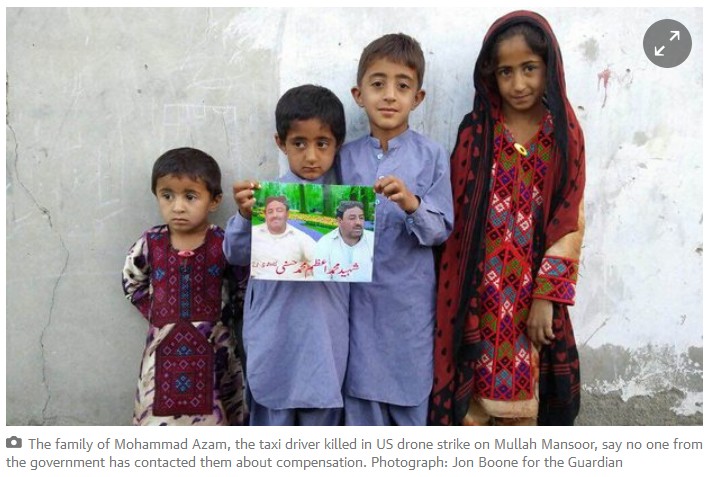Murder Most
Foul
Family of Driver Killed in US Attack File Criminal
Case
Relatives of Mohammad Azam, killed while driving
Mullah Mansoor across Pakistan, lodge a first
investigation report for murder
By Kiyya Baloch and Jon Boone in Islamabad

May 30,
2016 "Information
Clearing House"
- "The
Guardian"
- The family of a taxi driver who was killed in a
drone strike while driving the leader of the Afghan
Taliban across Pakistan have lodged a criminal
case against the US government.
Mohammad
Azam was killed on 21 May while unwittingly taking
Taliban leader Mullah Akhtar Mansoor from the
Iranian border to Quetta, the capital of Balochistan.
The family
of a taxi driver who was killed in a
drone strike while driving the leader of the Afghan
Taliban across Pakistan have lodged a criminal
case against the US government.
Mohammad
Azam was killed on 21 May while unwittingly taking
Taliban leader Mullah Akhtar Mansoor from the
Iranian border to Quetta, the capital of Balochistan.
He has
filed a “first investigation report” for murder,
naming the “US authorities” who claimed
responsibility for the attack. The police are now
obliged to investigate the matter. “I want justice
and demand action against the US authorities,” the
document reads.
It was a
series of chance occurrences that led to Azam
finding one of the US’s most wanted men sitting in
his white Toyota Corolla.
Azam got
much of his work though a small local transport
company owned by Habib Saoli, which has its office
near the exit of the Iranian-Pakistani border
facility that straddles the border.
Mansoor
emerged from that building shortly after 9am on 21
May, returning to Pakistan after a long visit to
Iran which,
it has been reported, was for both medical
attention and to visit members of his family.
He was
passing himself off as a Pakistani citizen using a
passport and national ID card with the false name
Muhammad Wali.
He
immediately began looking for a ride for the 600km
journey to the city of Quetta.
Said Ahmed
Jan, an employee of a bus company, was trying to
fill up the final seats of his Quetta-bound minibus
but Mansoor wasn’t interested.
“He said,
‘I want to go in a car’, so I called Habib and asked
him to provide a car,” said Jan. “Habib took a
little commission and gave the job to Azam.”
Saoli said
he could not remember whether Mansoor, who initially
tried to haggle down the 14,000 rupees (£90) charge,
had ever used one of his cars before.
Mansoor was
likely to have thought himself safe given the US is
not known to have carried out any operations inside
Balochistan despite the vast province being home to
many of the Taliban commanders with which the US has
been at war for 15 years.
The
situation is unlike Waziristan, a tribal region
hundreds of miles to the north, where militant
commanders operate in constant fear of the CIA’s
extensive drone programme.
In
Waziristan the targets are usually groups affiliated
with al-Qaida or the Haqqani Network, a Taliban
ally. It is almost unheard of for senior members of
the core Afghan Taliban, often known as the Quetta
Shura, to be attacked inside
Pakistan.
However the
US had already decided if it got the chance to kill
Mansoor, who the Pentagon described as an “obstacle
to peace” who was actively preventing Taliban
commanders from holding talks with representatives
of the Afghan government.
Attempting
to foster such a reconciliation process is now a key
part of US strategy in the region, with the country
having backed a Pakistan-led effort to bring the two
sides together.
But Mansoor
had been responsible for soaring violence in
Afghanistan, forcing the Kabul government to
abandon some territory to the insurgents.
It is not
known why the US waited to strike until Mansoor had
completed more than two-thirds of his journey,
having been on the road for almost six hours.
But the car
was finally destroyed by missile strikes in the
mid-afternoon, shortly after the pair had taken a
rest stop near the town of Ahmad Wal, roughly 35km
from Afghan airspace.
Qasim said
he could not believe the news of his brother’s death
when he received it, or understand how the leader of
the Taliban could have been able to travel so
freely.
“Why didn’t
the hundreds of paramilitary troops stop him like
they do with the common passengers?” he asked.
“Why did
the Americans kill him just for driving a car?” he
asked. “It was not written on [Mansoor’s] forehead
that he is a Taliban leader. He was travelling with
valid documents.”
Mureed
Shah, a local government official for the area, said
Azam had “no links with any militant group”.
“I know
Azam personally. He was working on a low-paid job to
support his poor family,” Shah said. “I have written
to the government in Quetta to pay compensation to
the family.”
Qasim said
no one from the government had as yet contacted him
about compensation.
The US army
has made payments to civilian victims of military
operations, including drone strikes, just over the
border in Afghanistan, but not in Pakistan.
Mustafa
Qadri, a drones expert from Amnesty International,
said the family had a right to bring a claim and
demand damages.
“The US has
itself said very openly that it seeks to minimise
civilian casualties and provide compensation and
other damages to civilians who die,” he said.
“So if this
is justified as a spill over from the Afghan
conflict why has the US not said anything about the
unintended victim of this strike?”
|